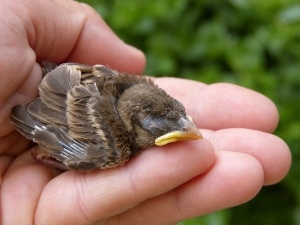
One of the things that many people say that you need when raising a bird from a very young age is a heat lamp, this will keep the baby bird warm when the mother isn’t round.
This article explores what you need to know about baby birds and using heat lamps.
Table of Contents
Baby bird heat lamp:
Using something to keep your baby birds warm is a must, baby birds are very fragile and if these birds aren’t kept warm they can die.
But there are a few things you need to know about warming the birds up using a heat lamp. This is what you need to know:
Why it’s needed:
While older birds are warm-blooded baby birds actually come out cold-blooded this is one of the reasons why they are exclusively dependent on their mother for warmth.
These birds only start becoming warm-blooded about a week into hatching, this is when they will start oxidizing their food and become warm-blooded.
In addition, because these animals are so small they have a huge surface area to volume ratio and this causes them to lose a lot of heat quickly and thus can’t keep themselves warm.
Because of the above, their mothers need to keep them warm in the wild but if they are in your care then they will need you to keep them warm.
What to look for:
The best way to do this is to use a non-light emitting heat lamp, a CHE, or a ceramic heat emitter bulb, this is the recommended solution as it is a close second to how the birds are kept warm in the wild.
Light from light-emitting heat lamps can be harsh in the little bird’s eyes so using one that doesn’t emit light is recommended.
Having a bright light on the birds is not recommended as this is far from the natural way that these birds are kept warm by their mothers, which is sitting in the nest and their mothers covering them up keeping light out and keeping warmth in.
The best solution for your birds is to re-create this warm dark environment that their mothers create in the wild.
How to use it:
Heat lamps, although useful, need to be used in the correct way for them to be effective for your little birds.
If you’re raising newly hatched birds that don’t have any feathers then you can place the heat lamp about 12 inches away from the birds.
It’s best to place the heat lamp above the aquarium so that the heat is distributed more evenly in the aquarium over the birds and isn’t only warming up the birds right in front of it which would happen if the lamp was on the side.
Give the birds areas where they can cool down away from the heat lamp as well. Section off the area right under the heat lamp so that the birds can’t get right under it.
You’d need to constantly monitor the temperature in the environment, do this with a digital thermometer and humidity reader to keep an eye on the temperature inside.
Alternative options:
A brooder:
Using a brooder for the birds is recommended over using a heat lamp. Brooders are built to keep these baby birds in and are designed to be as close to how these birds are kept warm in the wild as possible.
Heat pad:
If you don’t have a non-light emitting heat lamp and you don’t have a brooder to keep your birds in then you can use a heating pad to keep your birds warm.
Place this heating pad on the underside of the container that you’re keeping your birds in and cover this side keeping your birds from burning up when on this side. Only place half of the container on the heat pad.
This heating pad will emit heat into the container and warm the bird’s environment.
Keeping the heating pad on one side allows the birds to stand on this warm side and get warm and then move away to the other side to stay cool.
If the birds don’t have the option to move to a cooler side then the heating pad can burn or overheat the birds.
Use a heating pad with adjustable heat levels when wanting to warm your birds
Avoid using items that don’t allow you to maintain a constant temperature like a small heater. If the heat from the small heater gets out of control then the birds can become overheated.
If you enjoyed this article then you may also be interested in other bird related articles. Here are some articles that you may be interested in: Cockatiel Signs Of Stress, Cockatiel Temperament, Hand Feeding Cockatiel Problems, Why Does My Budgie Put His Foot On The Other Budgie?, Why Are My Conures Feathers Turning White?, Natural Anti-Inflammatory For Birds, Birds’ Feathers Curling Up

